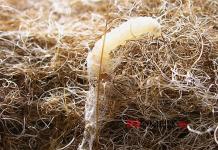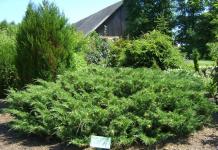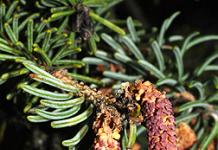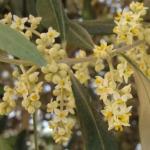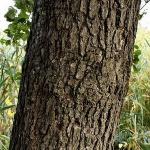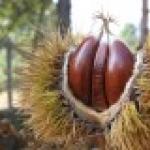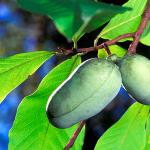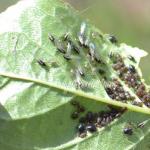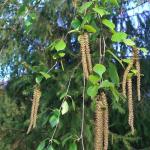General information, botanical description
Pawpaw (lat. asimina triloba) grows from the USA to Europe, China, and Japan. In the United States it is called differently: banana tree, due to the external similarity of the fruit, similar to the Spanish “papaya” name - “papaw”.
A deciduous tree with a brown-gray trunk reaches 6 m. The skeletal branches are located in the same plane. Pawpaw wood is fragile and soft, the branches often crack, unable to support the weight of its fruit. The leaves are oblong, glossy, alternate, concentrated at the apex with age.
Pawpaw blooms for up to 3 weeks in April-May, very impressively - this is evidenced by photos of its owners. The flowers are bell-shaped, brown-purple, up to 5 cm in diameter. The seeds are brown and large. The fruits are collected in clusters of 3-10 pieces, oblong-elongated, weighing 120-200 g, with greenish-yellow skin, amber or light beige pulp. The taste is sweet and cloying, similar to pineapple and strawberries. Ripe fruits have a delicate texture, very tender pulp - they are picked when they are ripe, since transportation is difficult.
Attention! The pawpaw growing season begins in early April. In the middle of the month, large buds with a dense shell that protects them from freezing swell. Depending on the variety, pawpaw ripens in mid-to-late summer or in September, and sheds its leathery leaves in October.
Basics of agricultural cultivation technology
- Illumination. Pawpaw seedlings are shaded to protect the leaves from burning out and the plants die. In the first year of growing pawpaws, the degree of shading is up to 70%. Trees 3-4 years old can withstand heat and grow without shading.

Banana tree fruit
- Soils. Slightly acidic, light, fertile. When growing pawpaws on dense soils, drainage is needed.
- Temperature regime. For the beginning of the growing season - from +10 °C, for fruiting the so-called. SAT (sum of active temperatures) over 26°C. Growing pawpaw is possible in the North Caucasus and Kuban, in the Lower Volga region and the Central Black Earth region.
- Watering. Regular, without moisture stagnation. From the beginning of September it is moderate.
- Fertilizer. Feeding is applied from 2 years of age. From April - NPK complex, manure, compost, ash. In autumn, phosphate-potassium fertilizers are important - they are applied at the roots, and the remaining leaves are sprayed.
- Pollination. An insect-pollinated (cross-pollinated) crop in temperate latitudes requires additional pollination. Gardeners transfer pollen with a brush from one tree to another.
- Frost resistance. Without shelter, it does not tolerate temperatures down to -20...-25 °C for long, but needs high-quality insulation, without which it dies. The trunks are wrapped in agro-fabric and wrapped in spruce branches.
Planting, replanting, pruning
For planting, 2-year-old seedlings are used due to better survival rate. Drying out of the fragile roots threatens the death of the pawpaw. For planting, seedlings are selected in containers and flowerpots. Seedlings of simultaneously flowering varieties are planted in pairs, spaced at a distance of 3 m.
Planting holes are filled with humus, sand if necessary, compost, and ash. When the seedling is immersed in the hole, the roots are straightened. After compacting the soil, water and mulch with peat and litter.

Transplantation is traumatic for pawpaw due to the special fragility of the roots. If necessary, replant in the spring using the transfer method, with a voluminous lump of earth.
Advice! In the northern regions, during autumn planting, seeds are best sown in flowerpots, and the next year the seedlings are transferred to open ground. Two-year-olds tolerate transplantation better.
Some gardeners believe that sanitary pruning is needed at the beginning of the growing season and the formation of the crown. Others do not consider it necessary when growing pawpaw: the plant itself forms a classic palm tree, or, as they say, palmette.
Reproduction methods and grafting
Pawpaw is propagated by seeds, less often by root cuttings. Information about propagation by cuttings is not true.
Attention! When propagated by the seed method, the so-called splitting, changing varietal characteristics.
- Reproduction by seeds. For better germination, stratification is carried out for 3-4 months. Pawpaw seeds germinate in about 7 weeks. When planted in autumn, at an average daily temperature of +10 °C, the seedlings will sprout in July-August. Seedlings are shaded and watered, reducing irrigation by September. When the temperature drops to +5 °C, the seedlings are insulated with agrofiber and mulch.
- Dividing the root. A small part of it is separated from the taproot and placed in a hole with a nutrient substrate. The appearance of shoots occurs in 30-40 days.
Advice! Pawpaw grown from seeds bears fruit for 4-6 years, grafted - for 2-3 years.
Pawpaw grafting is carried out using lignified cuttings, the so-called. spinning method The rootstock is split 1-1.5 cm, and a pointed scion is placed in the split. The cambial layers must match when combined. The place of fusion is wrapped with film and protected from moisture with caps.
Attention! Grafting pawpaw is the only method of crop propagation that preserves the characteristics inherent to the variety.
Diseases and pests
The crop is not prone to diseases even in its homeland, but is affected only by local North American caterpillars. In a continental climate, local pests do not attack plants. As for diseases, the culture is resistant to fungal flora and is not prone to viral infections. Only diseases of the root system are possible as a result of excessive watering or mechanical damage.

Pawpaw has been in cultivation for about 100 years, and has about 60 varieties. When growing pawpaw, gardeners are interested in early varieties obtained by universities in Michigan, Wisconsin, Ontario, and Russian selection. Such forms are known as Sochi 11 and Novokakhovchanka, Autumn Surprise and Dessertnaya.
Considering the variability of varietal characteristics, perhaps the next discovery will belong to those who today read about the southern fruit that conquered the North Caucasus and Kalmykia, settling in the Samara region and the Urals.
The banana tree looks decorative and gives us very tasty, sweet fruits, which many compare in shape to shortened bananas, and in taste to a number of tropical fruits, such as pineapple, banana, mango, papaya.
 Description.
Description.
Despite its exotic appearance, the three-lobed pawpaw (Asimina triloba) is not a tropical plant. It is a low (up to 4-5 meters, if not pruned) deciduous tree of the genus Asimina of the Anonaceae family. Pawpaw leaves are large (up to 30 cm in length), glossy, bright green. In autumn they turn yellow and fall off. The flowers are burgundy-brown, up to 5 cm in diameter, and have a faint, not very pleasant smell. Flowering occurs in April - May and lasts about three weeks.
The plant is cross-pollinated, so when growing at home (if, of course, you want to see the fruits), it is recommended to take it out into the garden at least for the spring and summer, or carry out pollination at home yourself (read how to do this here).
One flower usually bears several fruits at once. They are oblong, green at first, then yellow (and dark brown after frost), with large seeds, weighing from 20 g to 0.5 kg. They are not stored for long, usually no more than a week, so they are practically never found on store shelves.
Other names under which this plant is found: Nebraska banana, northern banana, dog banana, American papaya.
Open ground or pot? 
The homeland of the plant is North America. Today Azimina is also popular among gardeners in Europe and Japan. In Russia, the most suitable for growing plants in open ground are the southern regions of the country (such as: Krasnodar Territory, Republic of Adygea, Crimea, Stavropol Territory, Rostov and Astrakhan regions, etc.). Here Azimina winters well even without shelter.
However, residents of the northern regions can also enjoy sweet bananas. To do this, just plant Azimina in a pot. Starting from early spring (March-April) until late autumn (October-November), you can take the plant out into the garden, but for the winter it is better to remove it away from severe frosts.
Beneficial features.
Currently, the properties of the plant are still being studied, but some facts already exist. For example, it is well known that Azimina fruits contain many vitamins (they are especially rich in vitamins C and A) and microelements: potassium, calcium, phosphorus, magnesium, iron.
It is worth noting that the fruits are quite high in calories (about 360 kcal).
Indian peoples have used the plant's seeds as an emetic since ancient times.
 Growing.
Growing.
A big plus in favor of growing pawpaw is that it practically does not suffer from diseases and pests.
Popular varieties.
Martin, Overlease, Rebecca's Gold, Azimina Dessertnaya, Sochinskaya 11.
The soil.
Drained, fertile. The plant loves organic matter. Loves moisture, but does not tolerate stagnant water.
Place.
Well lit or diffused light. Young plants need shading after planting. Azimina does not like drafts either.
Reproduction. Landing.
Reproduction of Azimina is not the easiest thing. 
The seeds of the plant are difficult to germinate and require mandatory stratification before planting. But even with it they can take a long time to germinate (often not in the first year).
There are other ways to propagate a plant: using root shoots and grafting.
Root shoots are rare and very few in number. Young shoots do not tolerate transplantation well; they need quite a bit of time to get stronger.
Plant care.
Caring for Azimina involves the standard: regular watering, mulching around the tree trunks, spring-summer fertilizing (preferably 2-3, with an interval of two weeks) with complex fertilizer.
Pruning is carried out if necessary. It is best to do this in early spring, before the sap flows.
When grown in open ground, it is better to cover the plants (especially young ones) with a covering non-woven material for the winter. When grown in a tub, the plant must be moved indoors during the winter months.
Do you believe in fairy tales? If not, then you won't believe me now. Because I have a BANANA growing in my garden. You might think I live in Africa. Not at all, I live in the glorious city of Ulyanovsk, on the middle Volga. Already sometimes in October you have to dress well, in November it may snow, and in December it can be as cold as -15-20°, and even without snow. In January there will be frosts of -35°C for a week, and for a change in recent years the weather has been pampered with sudden thaws with rain. If we add to these delights of climate the piercing breeze from the great Russian Volga River, then not every apple or pear tree can take root here, let alone a banana.
I tried for a long time and unsuccessfully to cultivate a real tropical banana in my apartment. The Ukrainian varieties Kyiv dwarf and Kyiv superdwarf, selected by the Ukrainian amateur Anatoly Vasilyevich Patiya, died safely either from a lack of warmth and light, or from longing for their African homeland.
I shared my misfortune with the teacher of the Ivanovo Agricultural Academy, Evgeniy Kapitonovich Sirotkin. He sympathized with me and told me that there is a frost-resistant plant with fruits similar to a banana, and they call it ASIMINA TRILOBA or Nebraska banana. Having received a tiny pawpaw seedling from the botanical garden a year later, I came to the conclusion that I could try planting it in the garden.
The seedling did not inspire confidence in me; it was bare, dark brown, with a single apical bud. At the beginning of May, I planted it in a permanent place, adding a bucket of humus and a half-liter jar of wood ash to the planting hole.
Pawpaw is a deciduous tree of the Annonaceae family and its only extratropical species. It comes from North America, where it is bred on industrial plantations to produce sweet, very healthy fruits.
Finally, the apical bud began to grow and, having released several large leaves, 15 centimeters long and 6-7 centimeters wide, growth almost stopped. My palm tree, having stood motionless for almost two weeks, suddenly “shot out” and grew to 120 cm by August. In front of me stood a very beautiful tree with drooping large leathery leaves and a wide crown.
From mid-July, I stopped watering and fertilizing so that the growth had time to ripen by winter. In early October, I apply foliar feeding with superphosphate to all heat-loving crops - almonds, apricots, walnuts - to increase winter hardiness: 1 tbsp. l. I dissolve superphosphate in a bucket of warm water and spray the trees on the trunk, branches, and remaining leaves.
For the winter, I covered the banana tree well with spruce branches and, tying the trunk with newspapers, covered it with spunbond on top. Luckily for me, the winter was mild and the tree was not damaged.
And in the spring - in May - the leaves began to bloom, and I saw the first flower. It was large - 4 cm in diameter, similar to a bell - dark red in color. The pawpaw has grown a little in width and its crown has become very dense. I wanted to thin it out, and then I thought that I would not touch or cut it before winter.
In October the first fruit ripened. It looked a lot like a banana! From dark green it became bright yellow and soft. It was 14 cm long and 6 cm in diameter. Just a real plump banana. It tasted deliciously sweet and had a strong strawberry flavor. I thought that I would try to save this tree, even if I had to wrap several kilograms of newspapers on it.
Now my Nebraska banana is 170 cm high, level with me, which allows me to cover it for the winter with spunbond; I wrap the base of the trunk with a polypropylene flap from a sugar bag so that the root collar does not become warm during our unstable spring. This is what I do with all the “southerners” in my garden. This year we received 22 bananas of different sizes - approximately from 120 to 200. For our climate zone, this is a gift. And to the south, approximately from the latitude of Volgograd, pawpaw grows as a tree 4-6 m high, producing 25 kg of fruit or more.
If you ever want to grow this useful and interesting plant, please consider my experience. The Nebraska banana does not like strong winds; plant it behind the house, in a place relatively protected from the north wind. He loves organic matter, slightly acidic soil. When planting, add two buckets of humus into the hole, a little wood ash, if the soil is heavy, clayey, do not forget to put expanded clay or crushed stone at the bottom of the hole to drain excess water. In the spring, throw a handful of urea into it, and during the summer feed it several times with Kemira-Lux or any other complex fertilizer. In our country, from the second half of July, and in more southern regions from August, try not to water too much. It is better not to dig up pawpaw, but to plant it on a tree trunk, for example, a lawn or purslane will do. Regularly apply humus to the tree trunk every year.
Well, that’s all, I told you about meeting another interesting plant. Grow at least one new plant every year and you will feel all the charm of novelty and enthusiasm. I will always be glad to talk with you.
I give my article EXPERIENCE IN GROWING ASIMINA IN ORENBURG Lyashenko N.A.
Gardeners have always tried to grow rare, new and unknown fruit plants in their gardens. Southern fruit crops are increasingly found in our gardens. Advanced gardeners do not stop there; they continue to import and test new plants.
I first read about pawpaw three-lobed in the book by V.V. Petrov “Miracles of our subtropics”, and in 2007 I tried it for the first time. At the beginning of September, I came to the Institute of Mountain Horticulture and Floriculture to buy Virginia persimmon seeds, to see Doctor of Agricultural Sciences M.D. Omarov. In the next office, candidate of agricultural sciences Ksenofontova D.V. treated me to pawpaw. I liked the fruits; I have never tasted anything tastier in my life. And also many Russians living in Central Russia, not to mention the Urals, Siberia, the North and the Far East. In addition to the fact that pawpaw fruits are delicious, they are also filling. If the eastern persimmon needs 5-6 fruits to “kill the worm,” then 2-3 pawpaws are enough. I began to wonder what kind of plant it is, where it comes from, what temperatures are in the north of its range, how many degrees of frost it can withstand?
The pawpaw three-lobed is native to North America, it is the most winter-hardy species of the pawpaw genus, the only fruit plant from the Annonaceae family, distributed in the temperate zone to the Great Lakes (43° north latitude). G.N. Shlykov writes “...in the USA the northern border of Liquidambar styracitolia L. reaches 42° N. sh., where absolute minimums reach -35°С » . Has no pests. In America, pawpaw leaves are eaten by a caterpillar, whose butterfly is listed in the Red Book. For the information of gardeners, neither mice, nor hares, nor moose gnaw pawpaw. For best pollination, at least 2 plants are needed. Regarding the winter hardiness of pawpaw, the data is contradictory (you have to check everything yourself), from “its range extends to the north ... to the southern regions of Canada, which is characterized by frosts down to -30-40 ° C” (G.N. Shlykov, 1963) to “in Sochi often freezes to the root collar" (A.A. Kachalov, 1970). In an article by A.N. Maltseva, an employee of the Rostov Botanical Garden, it was reported that pawpaw withstood frost of -32°C without damage (but the temperature there did not drop below) . In “PH” No. 12, 2006, after M. Konoplev’s article “Rejuvenating bananas” on page 59, the editors wrote that pawpaw is a heat-loving plant. Yu.N. Karpun writes: ... “heat-loving
plants"...these are plants that require more heat than can be provided
specific point of introduction. Moreover, this requirement for heat is ambiguous: for some plants there is not enough heat during the growing season, while for others the winter period is too cold.”
To begin the growing season, it is necessary that the average daily temperature steadily exceeds + 10° C. For the ripening of fruits of the earliest forms, a sum of effective (over 10° C) temperatures of 2600° C is required (B. Bordelon, 2001, F. K. Ivanenko, 2008) , CAT for full plant development 3000-3100°C. These forms can be grown in areas where peach and
Medium ripening grapes. The high adaptive potential of the species allows us to confidently speak about the possibility of its cultivation in a large area of the South of Russia. Our gardeners, using various tricks, have learned to increase CAT to 500-700°C per season. “PH” has repeatedly written about these methods on its pages. Accordingly, regions with a sum of active temperatures of 2400-2500 ° C are suitable for growing pawpaw.
Needs abundant watering, but does not tolerate stagnation of water; drainage is required on dense soils. In addition to the North Caucasus and Kuban, when irrigated, pawpaw can be grown in the Lower Volga region (in the Astrakhan, Volgograd, Saratov regions and the Republic of Kalmykia). With watering and light shelter for the winter in the South: Central Chernozem region (in the Belgorod, Voronezh and Kursk regions); Middle Volga region (in the Samara region); Ural region (in the Orenburg region). The sum of active temperatures ranges from 2500°C (Middle Volga region) to 3700°C (Republic of Kalmykia), the average absolute minimum temperature is -28...-38°C, the duration of the frost-free period is 147-205 days.
The surest way to acclimatize plants during introduction is to grow them from seeds. From the very beginning (from sowing seeds, emergence of seedlings, etc.), the cultivation of pawpaw seedlings should be carried out in open ground conditions, excluding even a short-term stay in closed ground. During seed propagation, cleavage in many traits is observed in the offspring, which is used in selection for the introduction and acclimatization of pawpaws to the northern and eastern regions of the country.
If we plan to grow pawpaw in a region where it has not grown before, then it is necessary to focus on varieties and forms bred or growing in the north of the range, early ripening, with a short growing season, with good ripening of annual growth wood. I was at the institute in early September, when the fruits of the earliest forms and varieties were just ripening. I collected ripe fruits under different pawpaw trees in a collection garden; the more diverse the seed material, the greater the likelihood of getting what you need. Seeds are harvested when the fruits are fully ripe. In areas with a relatively short summer, only early forms will remain during seed propagation; in late forms, the seeds will not ripen.
After separation from the pulp, the seeds were stored in a plastic bag at the bottom of the refrigerator. After waiting until the average daily temperature dropped below 10 C, I planted the seeds in the ground and flowerpots. Seeds planted in late autumn germinate in July of the following year (although V.T. Kurdyukov from Korenovsk (Krasnodar Territory) claims that pawpaw seeds planted in the ground do not germinate). The first seedling from seeds planted in open ground on October 30, 2007, sprouted on July 3, 2008 (photo 1).
K.E. Zawisha (a gardener from Odessa) was asked on an Internet forum what needs to be done to make the leaves fly off on seedlings growing in a room in Novosibirsk. K.E. Zawisza recommended drying the plants.
Our seedlings sprouted in July-August, and in September we often have frosts, and in order to somehow prepare the plants, I stopped watering from the first of August, but not completely. During the day, the air temperature was 28°C, the broken branches from the maple, which were used to shade the pawpaw seedlings, burned out on the second day and were replaced with new ones (photo 2). In adult pawpaw plants, the leaves hang down, while in seedlings they are in a horizontal position. The seedlings were watered when, during a morning inspection from 6 to 8 o’clock, the turgor was not restored, i.e. The leaves remained drooping. By the end of August, the lower part of the seedlings began to become lignified, perhaps due to this, some of the seedlings overwintered. This is how a new agricultural technique appeared.
For the winter, when the temperature dropped to 5°C, the seedlings were covered with fallen leaves. The winter was peculiar: on December 24, 2008, there was -24°C, no snow, on January 3, 2009, snow fell, and on January 13, the temperature dropped to -31°C. With the onset of heat, when the average daily temperature exceeded 10°C, the leaves were removed.
Over the summer of 2008, the soil in the containers became compacted (sank), and a free space appeared between the edge of the container bottle and the soil, in which in the spring of 2009, melt (snow) water accumulated under the cover (leaves). It seeped through the shelter (foliage), but there was nowhere for it to go, the soil had not yet thawed after the winter, and white mold appeared around the stems of some seedlings, from which some of the seedlings died. To prevent this from happening again, in the fall of the first and second year of growing season, while the pawpaw seedlings are growing in containers, they are protected for the winter as follows: in the upper part of the container, two slits are made from top to bottom, 3-4 cm long, the slits are one opposite the other. When the upper part of the container is compressed, the cut edges slide over each other, thereby reducing the diameter of the container onto which a 1.5-liter bottle without a bottom is placed. The height of the remaining part of the bottle depends on the height of the seedling.
On May 9, 2009, the first buds in the flowerpot bloomed on the pawpaw seedlings. The seedlings endured the winter differently: in some, the buds bloomed at the root collar, in others in the upper part of the stem (photos 3, 4). Of the 54 seedlings that went into winter, 26 overwintered. Spring and early summer were hot. Regular care - watering, weeding. No fertilizers were applied. The growth was worse than in 2008, there was no shading, and some of the seedlings died. Pawpaw in natural habitats grows at high soil and air humidity; young seedlings without shading at high summer temperatures die en masse. The first two years the seedlings need to be shaded - the leaves burn in the sun. Plant resistance increases with age. The pawpaw has a tap root; if it is damaged during transplantation, the seedling dies; a container is needed for growing seedlings with a closed root system. Some of the plants were grown in containers (see PH No. 8, 2009). When sowing, the seeds were divided into two fractions: large and small. Watching!
for seedlings, I found out that large seeds germinate more quickly, the plants turned out to be stronger, two of them in the fall of 2009. were planted in a permanent place (photo 5)
From October 23 to October 24, 2009, the temperature dropped to -1°C at night. Even on October 25, the leaves did not completely fall off on all the seedlings; I had to brush them off. The earliest ones lost their leaves on October 18-19. During the autumn inspection, there were 15 seedlings in the ground, some of them were covered for the winter, some were left without shelter. This winter did not bring any surprises: December 8, 2009 - in the morning -22°C, no snow; December 13 – snow fell; December 14 – in the morning -7°C, snow 20 cm; December 16 – in the morning -26°C; December 18 - in the morning -33°C. In 2010, the temperature: January 19-21 - in the morning -27°C, January 22, 23 -32°C.
On May 7, 2010, the first buds bloomed on the transplanted seedlings overwintering without shelter. The sum of active temperatures for the period March – May 7, 2010 was = 355.7°C, and the sum of effective temperatures (over 10 C) = 115.1°C. The size of the largest leaves of pawpaw seedlings in ELC was as of May 25, 2010. ELC I – length 6 cm, width 3.5 cm; ELC II – length 9 cm, width 4 cm.
In the USA, the three-lobed pawpaw is called “paw-paw”, “Nebraska banana”, “banana tree”. These popular names of the plant are associated with the shape of the pawpaw fruit - they are elongated, like those of the pawpaw, but much smaller in size.
The main advantage of the three-lobed pawpaw is its wonderful fruits, for which it is grown. The taste of its fruits is extraordinary - it really resembles bananas, but softer, and the pulp of the pawpaw fruit has a strong and very pleasant aroma.
I must say that the pawpaw fruits seemed to me the most delicious of all that I had ever tasted. And so one day, when an acquaintance treated me to them, I really wanted to have such a crop on my site.
Having accumulated many years of experience in propagating and growing this plant, I would like to supplement the information posted on the site.
Pawpaw in nature and in the garden
The pawpaw genus includes 8 species distributed throughout the United States. Of these, six species grow in Florida, one is found in Texas. And one of the most common types of pawpaw grows throughout almost the entire territory of the country right up to the Canadian border - it is this one that is of the greatest interest for cultivation in our country. The botanical name of this common species is pawpaw three-lobed(Asimina triloba).
Pawpaw three-lobed (hereinafter - pawpaw) is a small deciduous slow-growing tree that lives on loose soils in floodplains. According to literature data, this plant tolerates frosts down to –25 C.
In the region where my garden is located (Tuapse), such severe frosts do not occur. But my friend, who lives near Krasnodar, in the harsh winter of 2005/2006, when the temperature dropped to -28 C, flower buds froze out on pawberry trees (although the wood and growth buds were not affected).
Pawpaw propagation by seeds
Pawpaw's seeds are very large, like those of.
I decided that pawpaw seeds needed because this plant comes from the subtropical and temperate zones.
Immediately after removal from the fruit, I placed the pawpaw seeds in loose, fertile soil, planting them in separate seedling cups. Then I buried the cups with seeds in the elevated areas of the garden, at a shallow depth.
During the winter, I made sure that water did not stagnate in the glasses with semans.
In April, some pawpaw seeds began to germinate, and I began to plant the seedlings in a permanent location.
During the spring, I carefully monitored the soil moisture, preventing it from drying out.
Since the soil on my site is heavy and clayey, before planting the seeds I completely replaced it with wood humus (I took it from the rotted trunks of edible chestnut, which is abundant in our forest).
I made planting holes for pawpaws of different sizes, placing them both in partial shade and in sunny areas. I made the largest hole about 1 meter deep and about half a meter in diameter - about 20 buckets of humus went into it.
Development of pawpaw seedlings and care for them
Pawpaw seedlings appeared from May to August, and out of the 14 seeds planted, 11 sprouted. In the first year, I did not feed the plants, I only watered the seedlings as needed. The growth of pawpaw seedlings during the first season ranged from 10 to 30 cm. In October, their leaves turned yellow and fell off; young trees went into a dormant state.
The following spring, in April, sap flow began among pawpaw seedlings, and buds began to bloom on their tops. At this time, I fertilized the young plants with nitrodiammophos (about 20 g per bucket of water), but did not detect any particular reaction to the fertilizer in the plants.
At the end of summer, I fed the young pawpaw trees, and did not fertilize them with anything else that season.
Simultaneously with the buds opening, 2 more pawpaw seeds sprouted on the overwintered plants, which had not sprouted last year.
In the second year, the growth of pawpaw seedlings also ranged from 10 to 30 cm.
In the third year, the last pawpaw seed sprouted, and the plants that sprouted in the first year grew from 20 to 40 cm.
It became obvious that young pawpaw trees growing in the shade developed worse than in the sun. Therefore, they had to be replanted, to which they reacted very painfully - growth stopped for 1-2 years.
In the fourth year, the pawpaw seedlings began to form lateral branches.
An interesting feature of the pawpaw tree is that its skeletal branches are formed strictly in one plane, i.e. represent a classic palmette.

In the photo: a small pawpaw tree in summer; Pawpaw in the fall.
Due to lack of free space in the garden, I kept only three pawpaw trees for myself, and gave away the rest of the seedlings.
As the pawpaw grew, over the years I began to increase the amount of fertilizing and the dose of fertilizer, and I only used.
It turned out that pawpaw is responsive to fertilizing, especially nitrogen-phosphorus fertilizers.
Flowering and fruiting of pawpaws
In the sixth year of cultivation, fruit buds began to form on one pawberry tree. They were the size of a match head, and became clearly visible after the leaves fell.
The following spring, pawpaw fruit buds began to bloom in March, long before the leaf buds opened.
In April, flowers of unusual shape and color bloomed from them - light brown, with 6 petals and a large number of stamens. Pawpaw flowers have a faint and very unpleasant odor, reminiscent of rotten meat. This smell attracts carrion flies, which are the main pollinators of pawpaw flowers in our conditions. And bees are not at all interested in pawpaw flowers.
Pawpaw can be pollinated by its own pollen, but pollination within the same flower is excluded. The fact is that in a pawpaw flower, the stigma of the pistil ripens first. After 1-2 days, pollen begins to fall out from the anthers of the stamens, and by this time the pistil withers. This is why the first pawpaw flowers do not produce ovaries.
In the first year, only 3 flowers bloomed on one pawpaw tree, and pollination did not take place.
The following year, one pawpaw tree had about 100 flowers, and the other about 70. Moreover, their flowering continued for 3 weeks, which made it possible to carry out both cross-pollination and pollination of flowers with their own pollen.
Pawpaw flowers are drooping, they are easy to pollinate - just tie a stiff wire to a piece of cotton wool and transfer the pollen from one flower to another.
Despite the pollination of pawpaw flowers by carrion flies, artificial pollination increases the percentage of fruit set. Even with artificial pollination, the ovaries produce about 60 percent of pollinated flowers, and about 80 percent of the formed ovaries fall off - this is a normal phenomenon.
Pawpaw flowers are often visited, but their participation in pollination is unlikely - these beetles are attracted only by the pollen of the plant, which they happily eat along with the stamens, but do not touch the ovaries.
Immediately after pollination of the ovary flowers, the pawpaws began to grow very actively. Within a month and a half, the ovaries reached half their final size.
In pawpaw fruits, from 2 to 8 fruits were formed (usually 2-3 fruits). There were also single fruits, but they were few.
Some pawpaw fruits reached considerable weight, so supports had to be placed under the heavy branches.
At the end of August and beginning of September, shortly before the pawpaw fruits ripened, they grew a little more and began to change color to lemon yellow.
When fully ripe, the pawpaw fruits fell off. And if they were damaged when dropped, they deteriorated very quickly - after only 3-4 hours at room temperature.
Intact ripe pawpaw fruits tasted best immediately after falling from the tree, and the next day they acquired the taste of burnt coffee ...
I tried picking pawpaw fruits from the tree shortly before they ripened. When they ripened in storage, their juiciness was very low.
It is interesting that in pawpaw fruit the fruits do not ripen at the same time. But the infructescence falls off only after the last fruit in it has ripened, which is why the first ripened fruits become overripe on the tree. Therefore, it is necessary to regularly check the degree of ripening of each fruit in pawpaw fruit after the fruit begins to change color.
Ripe pawpaw fruits easily come off when you touch them, while unripe ones hold on firmly.

In the photo: ripening pawpaw fruit; pawpaw fruits removed
Pawpaw fruits should be used immediately after they ripen. Their skin is very thin, translucent; it peels off easily, like a banana.
There is evidence in the literature that jam and compotes are made from pawpaw fruits. But I only used them fresh due to small yields.
It must be said that the yield of pawpaw in comparison with many other fruits is very low. Even in mature trees, the yield ranges from 25 to 40 kg of fruit per tree. But this drawback is compensated by the excellent taste of the fruit and the absolute resistance of this plant to.
In 26 years of growing pawpaw, I have not noticed any damage to my plants. And I have not heard from any of my friends who grow pawpaw that it was damaged in any way.
Pawpaw selection
Pawpaw was introduced into cultivation a little over 100 years ago, and therefore there are few varieties of it.
In total, about 60 varieties of three-lobed pawpaw are known. Different varieties of fruits differ in terms of ripening, size, and the size of seeds in the fruits. Obviously, in the near future, breeders will eliminate such a disadvantage as the low yield of pawpaw.
Now I grow five varieties (more precisely, varieties) of pawpaw in my garden. Of these, two varieties were obtained by me from the Institute of Mountain Horticulture in Sochi, where pawpaw breeding is carried out in Russia. One variety of pawpaw was purchased at the market, and its origin could not be established. Another variety of pawpaw was obtained from near Sukhumi, where pawpaw selection was carried out during Soviet times. And another one grew from the rootstock that was left after the death of the varietal pawpaw graft.
It must be said that the taste of the fruits of different varieties of pawpaw is very different from each other. The sweetest fruits turned out to be pawpaws from my rootstock, the graft on which died. And the pawpaw varieties from Sochi have the most unsweetened fruits; but they ripen later than others, which allows you to extend the period of consumption of fresh fruits.
At the end of August, the first pawpaw fruits ripen - on the tree that I received from near Sukhumi. They are sweet, but rather dry, and their weight rarely exceeds 100 g.
At the beginning of September, the fruits on the pawpaw tree that I bought at the market, as well as on the tree that grew from the rootstock, begin to ripen. In these two larger-fruited pawpaw varieties, the fruit weight reaches 200 g.
And finally, in October the fruits on the trees of Sochi selection ripen; their weight is also about 200 g. Below I will give the characteristics of these two varieties of pawpaw.
Three-bladed pawpaw “Sochinskaya-17”- fruits up to 200 g, harmonious taste (but, in my opinion, they have little sweetness), average yield.
Pawpaw three-lobed “Dessert”- the taste and size of the fruit is practically no different from the previous variety. But it has very small seeds, which increases the volume of pulp in the fruit. Productivity is average.
Pawpaw grafting
I would like to say a little about pawpaw grafting. In one of the articles I read that it is difficult to plant pawpaw - I cannot agree with this. From my own experience, I can say that grafting a pawpaw is no more difficult than a pear tree.
I graft pawpaw at the beginning of sap flow (in March) with a lignified cutting of a splitting tree. I cut the rootstock and split it lengthwise by 1-1.5 cm, and sharpen the scion into a wedge shape and insert it into the split of the rootstock. The cambial layers must coincide on at least one side.
I wrap the graft tightly with a polymer film, and cover it with a polymer cap on top to protect it from moisture.
The pawpaw graft usually takes root within 2 weeks, which can be judged by the time the buds awaken in the scion. After this, I remove the cap, but at first I do not completely open the place where the scion grows together with the rootstock (I just loosen the binding). Only after a month and a half, when the graft has taken root well, do I completely remove the bandage.
Out of six pawpaw vaccinations, five took root.
As a result of the grafting, I now have five varieties of pawpaw on three pawpaw trees: one tree has three varieties, and the other trees have one variety each.
Placing pawpaw trees in the garden
For the best fruiting of paws, it is important to choose the most suitable place for planting a tree.
As for the optimal placement of the pawpaw in the garden plot: it seems to me that, at least in the southern regions, the pawpaw should be placed in partial shade.
In my garden, one pawpaw tree grows near the forest on the border of the plot, where the sun is about 4 hours a day.
Another pawpaw grows next to a tree that shades the pawpaw in the first half of the day.
The third pawpaw tree grows between trellises with vines that protect it from the early morning and evening sun. As a result, this tree is in the sun for no more than 3 hours in the middle of the day, and it is on it that the best fruiting is observed.
In the gardening season of 2015, when September turned out to be dry and hot (daytime temperatures were no lower than +30 C), on a pawpaw tree that was in the sun for half a day, all the fruits on the sunny side were baked. And on the remaining pawpaw trees the fruits were not damaged.
So far, the yield of my pawpaw trees is low: it does not exceed 10 kg per tree. But I believe that over time my trees will be able to produce more.
I believe that pawpaw deserves wide distribution in household plots, at least in the south of our country.
Vladimir Vasilievich Chernyak (Tuapse, Russia)
On site site
on site site
on site site
on site site
|
|
Weekly Free Website Digest website
Every week, for 10 years, for our 100,000 subscribers, an excellent selection of relevant materials about flowers and gardens, as well as other useful information.
Subscribe and receive!
basic information
Name: pawpaw
Family: annonova
Origin: North America
Humidity: moderate
Location: bright areas of the garden
The soil: garden loose soil
Pests and illness: root damage due to high humidity
Height: 12 m
Bloom: April
Description of the plant
Three-lobed pawpaw is a tree with a wide pyramidal crown, growing up to 4-5, under favorable conditions - up to 12-15 m. In nature, it grows along river banks, in forests with moist, loose soil, and often forms dense thickets. The trunk and branches have gray smooth bark, young shoots are densely pubescent. Large, from 12 to 33 cm in length and 4.5-12 cm in width, petiolate leathery leaves of an oblong-ovate shape, pointed at the ends and tapering to the petioles, appear in late spring after the flowers bloom. The lower surface of young leaves is pubescent, reddish-brown, the upper surface is smooth, glossy, bright green, becoming light or gray-green over time.
- Flowering begins in April and lasts about 3 weeks. Flower buds, thanks to their insulating shell, withstand spring frosts well.
- Single, bell-shaped brown-purple or wine-red flowers hanging on a pubescent peduncle appear in the axils of last year's leaves, giving the plant a decorative appearance. Their diameter reaches 6 cm, each has several pistils, thanks to which the pawpaw plant can set up to 9 fruits from one flower.
- Bisexual flowers are protogenic, that is, the stigma of the pistil matures before the anthers open; pollination within one flower is excluded. The plant requires cross-pollination, for which it is recommended to have at least 2 varieties in the garden. The flowers have a faint unpleasant odor, reminiscent of spoiled meat, and are pollinated by flies, bees, and ants.
- Pawpaw fruits ripen in September-October and are juicy berries of an oblong-cylindrical shape, usually somewhat angular, varying in size and weight. Their length can be from 5 to 15-16 cm, width - 3-7 cm, weight - from 60 g to 200 g.
- Individual fruits are collected in fruit clusters of 2-3, sometimes up to 9 pieces, have a thin, translucent, easily removable skin and orange or whitish-yellow flesh, soft when ripe, similar in consistency to butter, very sweet, reminiscent in taste banana and mango, with a sharp strawberry-pineapple scent. The color of the peel is initially dark green, then it gradually lightens and becomes lemon yellow, and after the first frost it turns black.

Beneficial features
Currently, the properties of the plant are still being studied, but some facts already exist. For example, it is well known that Azimina fruits contain many vitamins (they are especially rich in vitamins C and A) and microelements: potassium, calcium, phosphorus, magnesium, iron. It is worth noting that the fruits are quite high in calories (about 360 kcal). Indian peoples have used the plant's seeds as an emetic since ancient times.
Landing Azimina
On the territory of our country, growing pawpaw is possible in areas with a warm climate that provide at least 160 frost-free days (Krasnodar Territory, Kuban, Caucasus). Mature trees are light-loving and produce maximum yield in full sunlight; young plantings suffer from direct sunlight in the first two years and need shading. Trees are watered regularly, trunk circles and row spacing are mulched, which helps retain moisture in the soil and prevents it from overheating in the summer months. As the seedlings grow, they switch to artificial turf with perennial grasses, periodically mowing them and using them as mulch. During the period of active growth, pawpaw is fed once every 2 weeks with organic or complete mineral fertilizer. In the spring, sanitary pruning and replacement pruning are performed. The plant is little affected by diseases and pests.

Reproduction in shifts
Pawpaw is propagated by seeds, root layering and grafting. Root shoots are usually few in number, weakly grow the root system and do not tolerate transplantation well. For propagation, it is recommended to separate it from the mother plant a year before the planned transplant. Pawpaw seeds require stratification, otherwise their germination may take up to 3 years. Stratified seeds sown in late autumn germinate in July. Young plants develop poorly in the first year and do not tolerate transplantation well. Specimens grown from seeds bloom in 4-8 years, grafted ones - after 2-3 years, but grafting trees is quite difficult.
The surest way to acclimatize plants is still considered to be growing them from seeds. If pawpaw is grown where it has not grown before, it is necessary to focus on varieties and forms of early ripening, bred or growing in the north of its range, with a short growing season and with good ripening of annual growth wood. Pawpaw seeds dry out quickly after being removed from the fruit - after only 5 days of storage in the open air, the water content in them decreases sharply, which leads to loss of germination. To maintain viability, seeds removed from fruits are best stored in a moist substrate. To obtain good seedlings, cold stratification (0–5 °C) of seeds is necessary for 3–4 months. In stratified seeds, under warm conditions, additional development of the root and cotyledons occurs, which ensures a more or less uniform emergence of seedlings. Seeds should be sown to a depth of 2–3 cm. Mass shoots appear after a month, and individual shoots after 2 months. The germination rate of properly stored seeds is 80%. Stratified seeds sown in the ground germinate at an air temperature of at least 18–22 °C; in our conditions, seedlings appear in late May - early June, regardless of the timing of spring sowing.
In the first year, seedlings reach a height of 10–15 cm, have 6–10 leaves, and the root collar is 1.5–3 mm in diameter. The root of a seedling is a tap root; the root system of annual plants is 150–170 cm long, located in the soil at a depth of up to 20 cm. When transplanting seedlings from a greenhouse to a nursery, the roots very often break, so you need to replant them with a lump of earth or sow them directly into containers from which can then be easily transferred to the prepared planting hole. To grow varietal planting material, pawpaw is propagated by budding during mass flowering of plants (usually in Kyiv conditions - May 5–15), the grafting survival rate is 75–90%. Budding (and grafting) of pawpaws must be carried out quickly and carefully, using a stainless steel knife, since the sections quickly oxidize due to the high content of tannins in air. Pawpaw plants also form root shoots, which can be dug up and used as planting material. Plants of seed origin bloom only in the 5th–6th year after planting, the yield increases gradually, grafted ones already in the 2nd–3rd year and quickly begin to bear fruit. The harvest is formed on last year's shoots and depends on the vigor of the plant, growing conditions, as well as the presence of pollinating insects and cross-pollination. Full mass fruiting is typical for 10–15 year old plants.
Propagation by root parts
Root suckers:
- The root shoots are broken off;
- plant deep in the soil, water;
- sprouts appear in about a month.
For planting use seedlings or seedlings paws. Two-year-old seedlings 40–50 cm high with a root collar diameter of 6–9 mm have 14–20 leaves and a total length of the root system of 2.5–3 m. – 10–12 mm, they should have good fusion of the scion with the rootstock. For planting pawpaws, an elevated, wind-protected and well-lit place is best suited. When landing on a slope, to prevent the flow of storm or melt water, it is necessary to equip drains. The optimal planting pattern, which ensures good plant development, is 3 m between plants and 5 m between rows. On a personal plot, the feeding area may be smaller - 2.5 x 4 m, but given that pawpaw grows well and develops quickly, it is advisable not to plant other plants close. The depth of the planting holes is 50–60 cm, the width is 60–70 cm. The soil from the top layer of the hole is mixed with 5–10 kg of compost or humus, the plant is planted on a mound, straightening the root system, the hole is filled with soil from the rows, and a hole is made for watering. After planting, the plants are watered and mulched with peat, bark, and humus. During the growing season, water as needed.

Care rules
- Slightly acidic soil, rich in organic matter, fertilize with humus with the addition of ash;
- fertilizing with urea in spring, and complex fertilizer 3-4 times in summer;
- mulch the tree trunk circle or sow it with lawn grass;
- good lighting;
- no drafts.
It is recommended to fertilize pawpaw with humus infused for 24 hours with the addition of fish broth. This composition promotes the growth of the banana tree. Infusions of lupine or quinoa have a positive effect on the development of the tree. Fertilizers are added only to moist soil so as not to damage the branched root system of the pawpaw. For the same purpose, you cannot loosen deeper than 1 cm.
Diseases and pests
Pawpaw is resistant to diseases and pests. But improper watering can cause root rot. In this case, the leaves turn brown and the pawpaw grows poorly. Balance in moisture and watering regime are important. In indoor conditions, replanting the plant will help. Pawpaw roots should be rinsed well with water, removing diseased areas. To prevent pests from time to time, pawpaw can be watered with a weak solution of manganese.
